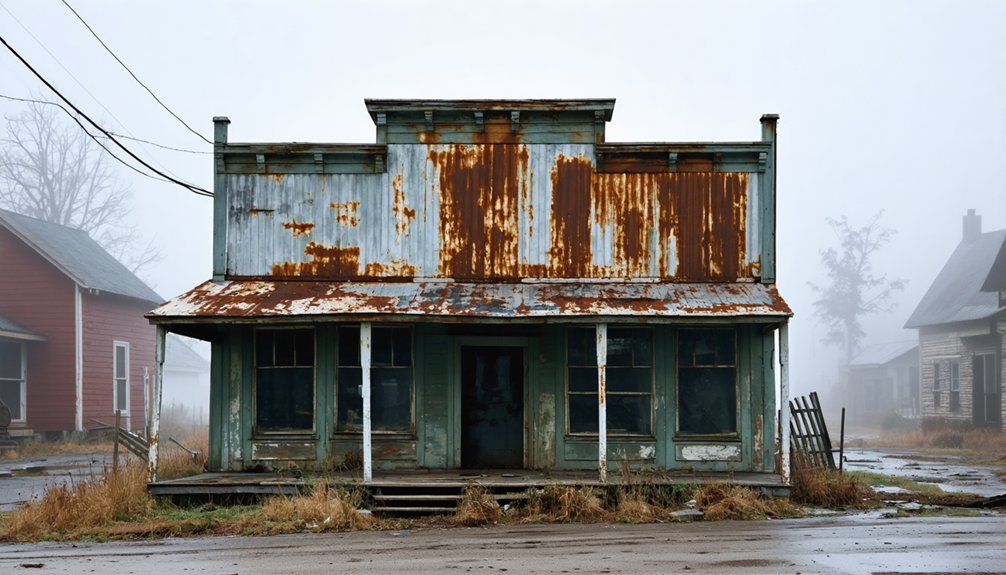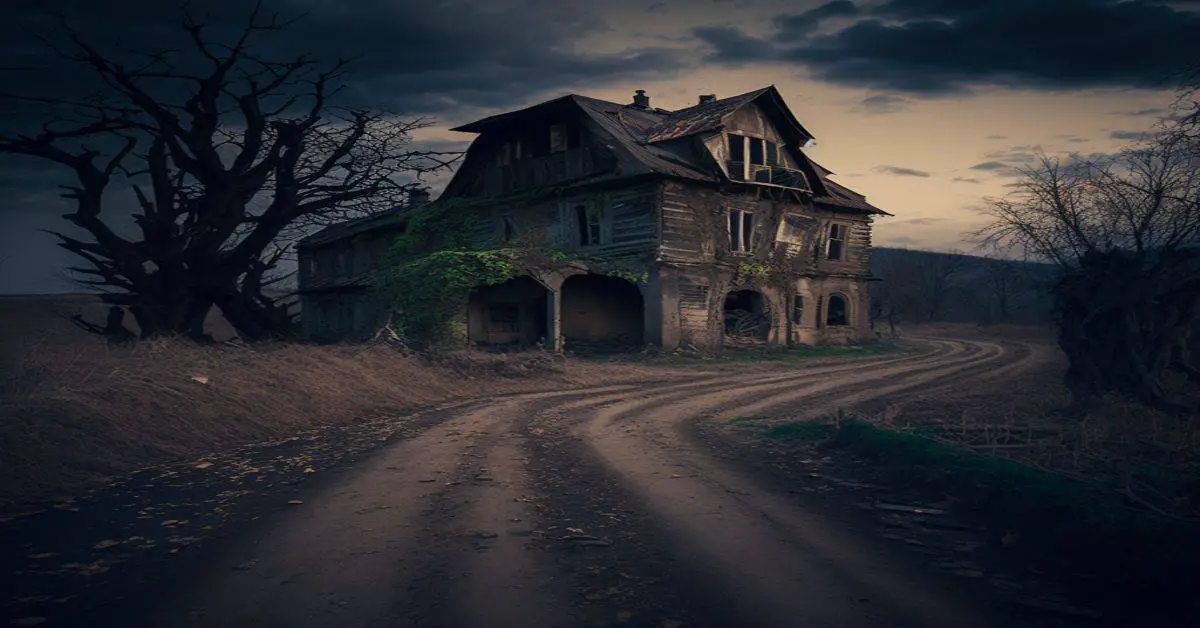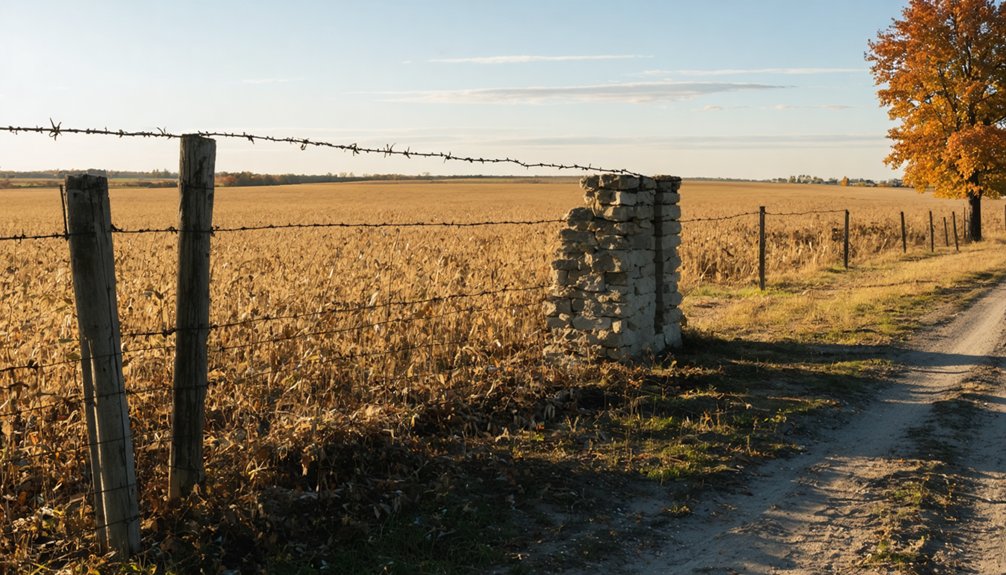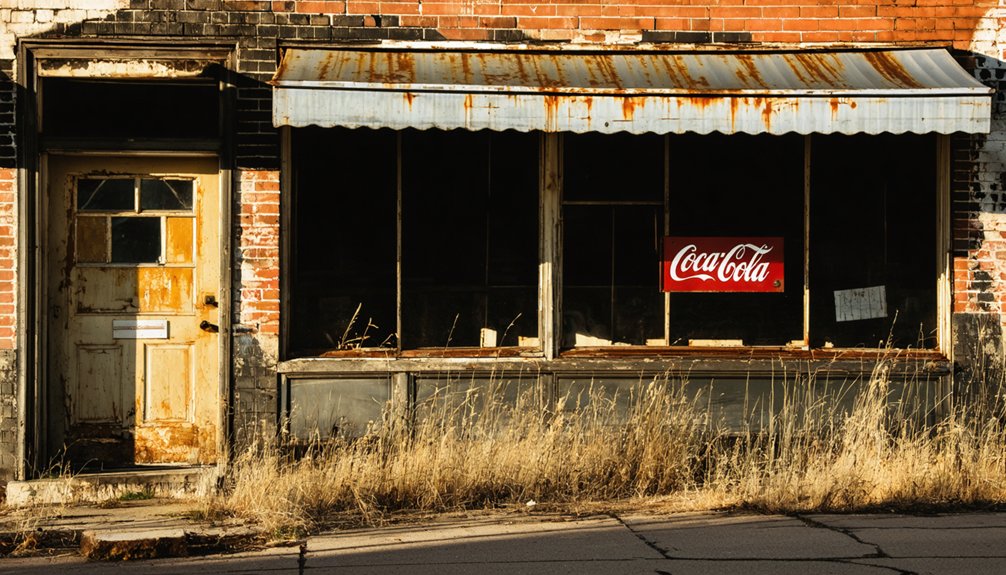You’ll find Sylvan’s remains in Cass County, Illinois, where Irish immigrants built a close-knit farming community in the mid-1800s. The settlement thrived near Panther Creek with fewer than 200 residents living in simple wood-frame farmhouses, cultivating corn, wheat, and soybeans. Today, only a solitary cemetery marks where this vibrant community once stood. The story behind Sylvan’s gradual decline reveals broader patterns in rural America’s transformation.
Key Takeaways
- Sylvan was a 19th-century Irish immigrant settlement in Cass County, Illinois, that flourished as a farming community before becoming abandoned.
- Only a solitary cemetery remains today as evidence of the former settlement near Panther Creek Township.
- The community declined due to isolation from major transportation routes and economic stagnation in rural areas.
- Originally home to fewer than 200 residents, Sylvan’s economy centered around farming crops like corn, soybeans, and wheat.
- The ghost town site offers minimal visitor facilities, with most of the former settlement area now reclaimed by nature.
The Rise and Fall of a Rural Settlement
While many rural settlements in Illinois grew from diverse roots, Sylvan emerged distinctly as a mid-19th century Irish immigrant community.
You’ll find the town’s story woven deeply with the hopes of families who crossed the Atlantic seeking new opportunities in America’s heartland. These determined settlers brought their cultural traditions with them, establishing a close-knit community where Irish customs shaped daily life. Their connection to nature was evident in the idealized countryside scene they cultivated around their settlement. Much like Old Shawnee Town, flooding posed a constant threat that required building protective levees to safeguard the community.
Irish immigrants carried their heritage across the ocean, weaving their traditions into the fabric of a new American community.
Like many small farming communities of the era, Sylvan’s residents came together for community events, sharing both their struggles and celebrations.
But despite their strong bonds, the settlement couldn’t sustain itself through changing times.
Today, only a solitary cemetery remains as a tribute to those pioneering Irish families who once called Sylvan home, their dreams now echoing across abandoned fields.
Geographic Location and Terrain
You’ll find Sylvan’s ghost town remains nestled in the prairie landscape of Cass County, where the former settlement took advantage of the region’s rich, fertile soils typical of central Illinois farmland.
The town’s strategic placement near Panther Creek provided essential water access for early settlers while maintaining proximity to what’s now Jim Edgar Park.
The site’s gentle terrain and natural drainage patterns made it an attractive location for rural development, though today only the cemetery marks where this once-promising community stood. The area’s soil composition allowed for effective bioremediation techniques that helped restore the land’s natural balance. Local historians note that like nearby Silvin Island, the area’s limestone deposits indicate past quarrying activities in the region.
Prairie Landscape Features
Located in Panther Creek Township, Cass County, Illinois, Sylvan’s prairie landscape exemplifies the region’s characteristic flat to gently rolling terrain.
You’ll find the area’s rich soil reflects its Grand Prairie heritage, where tallgrass species once dominated the natural vegetation. While much of the original prairie has given way to agricultural fields, you can still spot patches of native flora around the cemetery and near Jim Edgar Park.
The landscape you’ll encounter today tells a story of transformation. Small waterways, including Panther Creek, weave through the terrain, creating diverse microhabitats for prairie restoration efforts.
Despite years of farming, the land’s gentle contours remain largely unchanged, offering glimpses of how the prairie appeared before settlement, when Irish immigrants first made this their home.
Rural Settlement Placement
The strategic placement of Sylvan within Panther Creek Township exemplifies the thoughtful site selection common among 19th-century rural settlements.
You’ll find the town’s location at roughly 40°N latitude and 90°W longitude, where settlement dynamics favored gently rolling terrain that supported both farming and transportation needs.
The founders chose this spot southwest of Newmansville with careful consideration of rural infrastructure requirements. They positioned the community near Panther Creek, ensuring reliable water access while avoiding flood-prone areas.
The terrain’s natural advantages – fertile prairie soil, moderate slopes, and proximity to timber resources – made it ideal for agricultural development. The land’s inherent drainage patterns and relatively flat topography also simplified the construction of roads and buildings essential to community growth.
Cass County Boundaries
Situated within Illinois’s fertile heartland, Cass County spans 384 square miles of mainly agricultural terrain at approximately 40°N latitude and 90.25°W longitude.
You’ll find the county’s boundaries shaped by significant boundary adjustments since its 1837 establishment from Morgan County territory, with a notable southward expansion in 1845.
The county geography features the Illinois River, Sangamon River, and Little Sangamon River, which have carved valleys through the landscape. The area includes detailed township and range parcels that aid in precise land surveying and property identification. This area requires careful disambiguation efforts due to similarly named Cass Counties existing in other U.S. states.
Six counties border Cass: Mason to the northeast, Menard to the east, Sangamon to the southeast, Morgan to the south, Brown to the west, and Schuyler to the northwest.
The terrain includes protected natural areas like Jim Edgar Panther Creek State Fish and Wildlife Area and portions of the Meredosia National Wildlife Refuge.
Life in 19th Century Sylvan
During the mid-19th century, Irish immigrants formed the heart of Sylvan’s close-knit rural community, where life centered around farming and mutual support.
You’d find fewer than 200 residents here, mostly living in simple wood-frame farmhouses that served as both homes and workspaces. Community dynamics revolved around shared labor, church gatherings, and seasonal festivities that kept Irish traditions alive.
Daily life meant traversing dirt roads and horse-drawn transportation to reach nearby markets. While farming dominated the economy, you’d also find blacksmiths, carpenters, and craftsmen supporting the agricultural lifestyle.
Immigrant experiences shaped everything from social gatherings to building techniques, creating a resilient community where families relied on each other’s skills and support to thrive in their new American homeland. The settlement was established two and a half miles from Newmansville, providing convenient access to additional resources and trade opportunities.
Agricultural Heritage
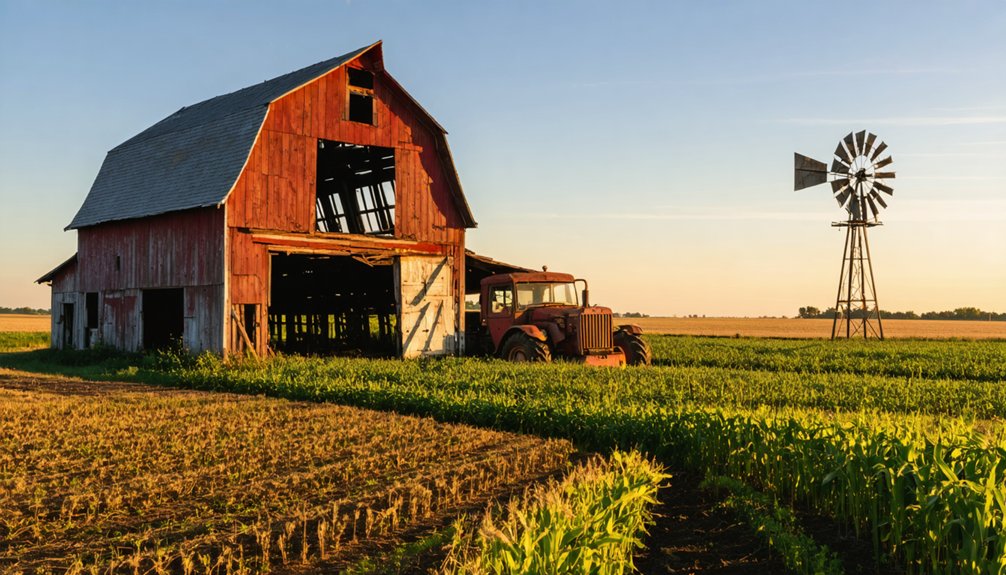
You’ll find that Sylvan’s earliest farmers worked the rich alluvial soils near streams and gravelly fire-clay bluffs, carefully choosing crops suited to each soil type.
The region benefited from two major railroads that connected farmers to broader markets.
Our agricultural roots included wheat and corn as primary crops, processed through local grain elevators that could handle thousands of bushels daily and load multiple rail cars.
The Sullivan Grain Co. built a substantial elevator in 1873 that could store up to 10,000 bushels of grain at once.
The last working farms in Sylvan maintained this mixed-use tradition, integrating crop fields, pastures, and groves of maple, elm, and fruit trees that had survived from the original timber stands.
Farming Before Modern Methods
Before modern machinery transformed agriculture, farming in Sylvan relied heavily on manual labor and time-tested techniques passed down through generations.
You’d find families working together, using hand tools like hoes and sickles to tend their diverse crops. They’d carefully rotate their plantings to keep the soil rich, supplementing it with manure from their livestock. An old hay baler near abandoned buildings serves as a reminder of early farming implements.
Your success as a Sylvan farmer depended on understanding the land’s natural rhythms. You’d plow with horses or oxen, plant by hand, and join your neighbors for harvest work bees.
Local knowledge guided decisions about which crops would thrive in different soil types. Crop diversity protected against total crop failure, while careful seed saving guaranteed you’d have sturdy, locally-adapted varieties for next year’s planting.
Crop Types and Production
Three major crops dominated Sylvan’s agricultural landscape: corn, soybeans, and wheat.
You’d have seen local farmers practicing smart crop rotation techniques to maintain soil health and maximize yields.
While corn and soybeans brought in the most revenue, specialty crops like buckwheat added diversity to the region’s agricultural portfolio.
Last Working Farms
While modern agriculture has transformed much of Illinois’s farmland, Sylvan’s agricultural heritage lives on through its sesquicentennial family farms – properties that have remained in continuous family ownership for over 150 years.
You’ll find these last farms standing as proud representations of the region’s farming traditions, with the Sullivan family’s 178-year-old operation leading the way through eight generations of stewardship.
As rural decline threatens smaller agricultural communities, these historic properties maintain their original land parcels from 19th-century grants.
Before mechanization changed everything, you’d have seen these farms buzzing with activity – purebred Angus cattle, Duroc hogs, and diverse crop operations spanning hundreds of acres.
Even through the labor shortages of both World Wars, these resilient families kept their farms productive, adapting to survive while preserving their agricultural legacy.
Remnants and Physical Evidence
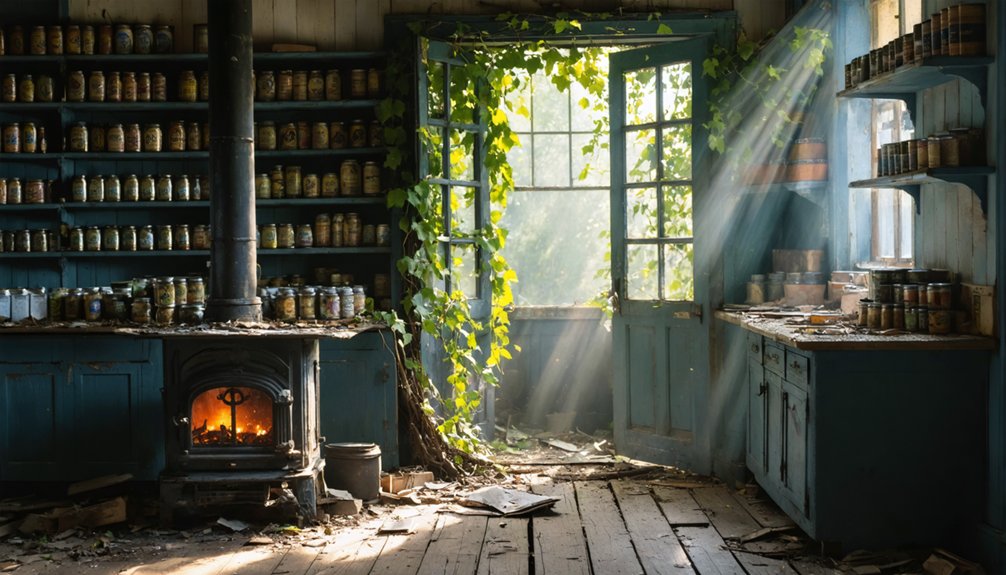
Today, scattered remnants of Sylvan’s past dot the landscape around Jim Edgar Park, offering glimpses into this once-thriving Illinois community.
You’ll find historical remnants like the old cemetery, which stands as a solemn tribute to the town’s Irish heritage. A few weathered farmhouses still defy time, though nature steadily reclaims their surroundings with persistent vegetation and wild growth.
As you explore the area, you’ll notice abandoned structures slowly succumbing to the elements, their weathered facades telling stories of bygone days. The absence of modern amenities reminds you of simpler times, while old road traces and walking paths weave through overgrown fields.
Despite decades of abandonment, these physical remnants preserve the memory of Sylvan’s vibrant past, offering a tangible connection to its agricultural roots.
Historical Documentation
Records of Sylvan’s existence paint a modest but distinct portrait of this Irish immigrant settlement in Panther Creek Township, Cass County.
Through historical narratives preserved in local history books and government records, you’ll find evidence of a tight-knit farming community that flourished briefly in the mid-1800s. The most thorough documentation appears in the Sylvan Lake History Book (1991), while archival research reveals the settlement’s presence on antique maps southwest of Newmansville.
Census data confirms the town’s mostly Irish population, though exact numbers remain elusive. While physical traces have largely vanished, cultural references persist, including an unexpected appearance in the film Silent Hill, where the town’s name was misspelled as “Sylvane.”
The settlement’s GNIS feature ID 423227 stands as official recognition of its historical significance.
Local Demographics Over Time
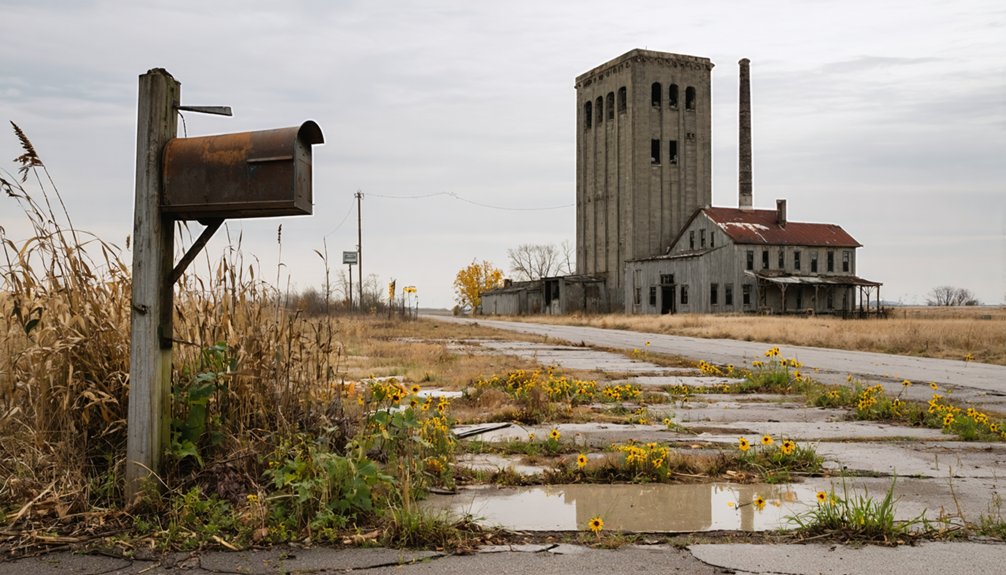
Throughout its brief but vibrant history, Sylvan’s population consisted primarily of Irish immigrants who settled in this quiet corner of Panther Creek Township during the mid-1800s.
The Irish influence shaped every aspect of local life, from community gatherings to cultural traditions that defined daily activities. You’ll find evidence of this rich heritage in the remaining farmhouses and the historic cemetery that still stands as a memorial to these early settlers.
As time progressed, the tight-knit community dynamics that once characterized Sylvan gradually diminished.
The town’s population dwindled as residents sought opportunities elsewhere, eventually leading to its current status as a ghost town. While no permanent residents remain today, the area’s Irish roots continue to echo through local stories and the physical remnants of this once-thriving settlement.
Factors Leading to Abandonment
Despite its early promise as an Irish farming settlement, Sylvan’s decline stemmed from multiple interconnected challenges that proved insurmountable for the small community.
You’ll find that the town’s isolation from major transportation routes, particularly railroads, severely limited its economic potential. Without reliable infrastructure, economic stagnation took hold as businesses and residents sought opportunities in better-connected towns nearby.
The exodus of families broke down community cohesion, leading to the closure of schools and local establishments.
As the Quad Cities’ industrial boom drew workers away, Sylvan couldn’t compete with the diverse employment options in larger urban centers.
The town’s geographic location, positioned away from major waterways and valuable natural resources, offered few advantages to sustain growth or attract new investment.
Comparison With Regional Ghost Towns
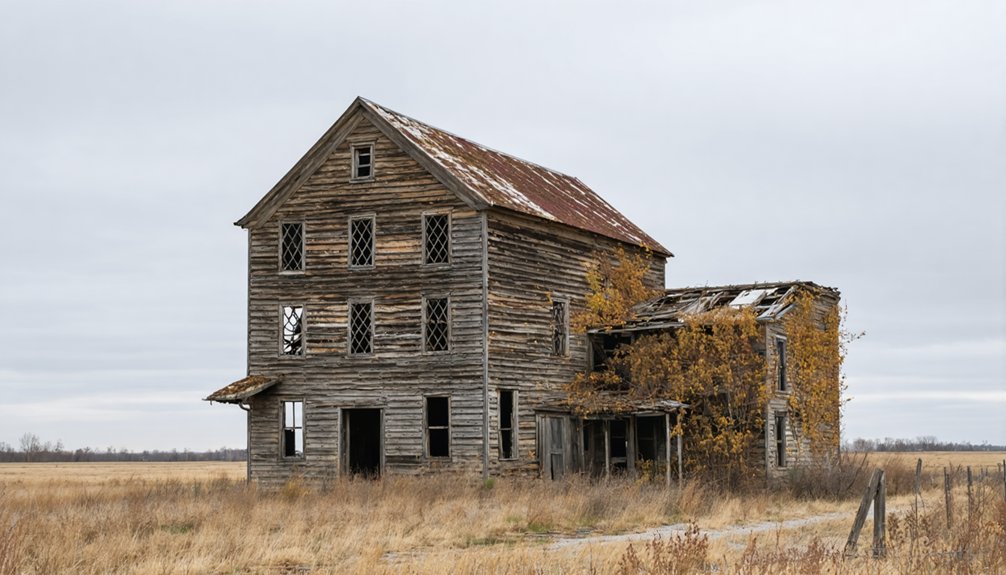
While you’ll find that Sylvan’s quiet decline differed from more abrupt abandonments seen in regional ghost towns that lost crucial rail connections, its gradual fade matched the pattern of many small farming communities bypassed by major transportation routes.
You can trace how nearby Murpheysboro’s destiny shifted dramatically after the railroad chose an alternate path, leading to its rapid desertion despite having more established businesses and a school.
Sylvan’s agricultural focus meant it wasn’t as dependent on rail commerce as some neighbors, yet this self-sufficiency couldn’t ultimately prevent its population from seeking opportunities in better-connected towns.
Railroad Impact Differences
As railroad development shaped Illinois settlements in the late 1800s, Sylvan’s story stands in stark contrast to other regional ghost towns that rose and fell with the rail lines.
Unlike Buda or the Tunnel Hill communities, which built their economies around railroad dependency, Sylvan never relied on rail infrastructure for its survival.
You’ll find that towns like Buda flourished with their roundhouses and depots, while the Tunnel Hill settlements thrived on rail commerce and worker populations.
When economic shifts forced rail lines to close, these communities quickly collapsed.
Sylvan’s decline, however, followed a different path. As a rural Irish settlement without direct rail access, it simply faded as broader industrial and commercial activity gravitated toward rail-connected areas, leaving only its cemetery as a reflection of its existence.
Economic Viability Patterns
Through careful analysis of economic patterns, Sylvan’s trajectory differs markedly from other Illinois ghost towns. While Shawneetown battled devastating floods and Benld struggled with coal mining decline, Sylvan’s story centers on its agricultural roots and isolation.
You’ll notice that its economic resilience was particularly challenged by limited market access and transportation infrastructure. Unlike Buda, which at least had railroad connections before its decline, Sylvan’s remote location magnified its vulnerability to population shifts.
The town’s heavy reliance on agriculture, without diversifying into other industries, proved fatal to its survival. When you compare it to regional ghost towns, Sylvan’s decline wasn’t triggered by a single catastrophic event like flooding or mine closures, but rather by a gradual erosion of its economic foundation through rural-urban migration.
Modern-Day Site Conditions
Today, visitors to Sylvan, Illinois will find little evidence of the once-thriving community that stood here. The site’s modern accessibility is limited to open fields and a solitary cemetery, with no developed facilities or interpretive markers to guide your exploration.
Time has erased all traces of Sylvan except empty fields and a lonely cemetery, leaving visitors to imagine its former vitality.
You’ll notice a few scattered farmhouses in the surrounding area, though these weren’t part of the original settlement.
At 607 feet above sea level, the ghost town preservation efforts are minimal, with nature largely reclaiming the landscape. There’s no visible street grid or building foundations to mark where the town once stood.
While you’re free to explore the site, you’ll find more activity at the nearby Jim Edgar Panther Creek State Fish and Wildlife Area, which has become the region’s primary draw for outdoor enthusiasts.
Frequently Asked Questions
Were There Any Notable Crimes or Mysterious Events in Sylvan’s History?
You won’t find any documented unsolved mysteries or ghostly sightings here – historical records show no notable crimes or strange events during the town’s active years before its quiet decline.
What Native American Tribes Originally Inhabited the Sylvan Area?
With 60,000-80,000 members in the 1600s, the Illinois Confederation first controlled your area’s cultural heritage. Later, the Kickapoo became dominant until they’d ceded their lands through treaties by 1819.
Did Any Famous or Historically Significant People Come From Sylvan?
You won’t find any famous residents or people of historical significance from this small Irish immigrant settlement. Historical records don’t show any notable individuals emerging from Sylvan’s brief existence.
What Was the Maximum Recorded Population of Sylvan at Its Peak?
Precisely pinpointing population trends isn’t possible, as you’ll find no maximum recorded population exists. Historical significance suggests fewer than 100 residents at its peak, based on settlement classifications and remaining evidence.
Were There Any Natural Disasters That Contributed to Sylvan’s Decline?
You won’t find records of flood damage or drought impact causing Sylvan’s decline. While other Illinois towns faced natural disasters, the available historical data doesn’t point to these as factors in Sylvan’s abandonment.
References
- https://kids.kiddle.co/Sylvan
- https://drloihjournal.blogspot.com/search/label/Lost Towns of Illinois
- https://www.youtube.com/watch?v=7XfrzF-Wgng
- https://drloihjournal.blogspot.com/2022/09/lost-towns-of-illinois-sylvan-illinois.html
- https://www.youtube.com/watch?v=md99IYopVSM
- https://www.onlyinyourstate.com/nature/illinois/sylvan-island-hike-il
- https://en.wikipedia.org/wiki/List_of_ghost_towns_in_Illinois
- https://en.wikipedia.org/wiki/Sylvan
- https://www.youtube.com/watch?v=fy3yJDBA5nI
- http://cantontornado36.blogspot.com/2017/04/ghost-towns-of-fulton-county-illinois.html
